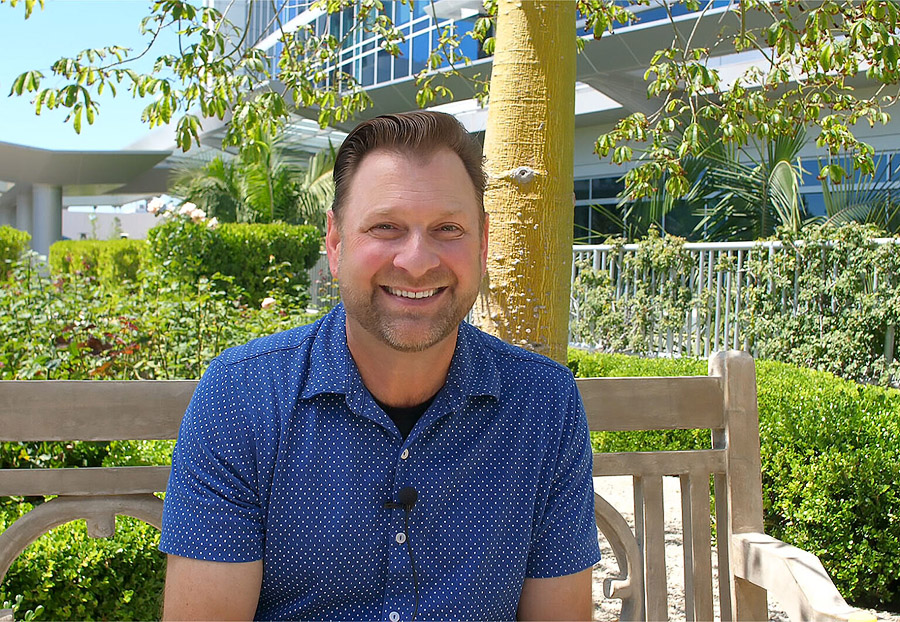
A New Treatment That Was Worth the Wait
In 2019, after 5 years of watchful waiting, Scott Millward went to see a specialist at USC Keck School of Medicine for his benign thyroid nodule, which he was initially diagnosed with in 2014. It had grown to a 5.5 cm tumor and was protruding out of his neck, “It was golf ball-sized,” he says in his testimonial below. The specialist told him he had a certain window for treatment before it progressed. He asked what treatments there were available, and surgery to remove his entire thyroid was recommended. Scott was motivated to find an alternative treatment to removing his thyroid, known as thyroidectomy. Patients with their thyroid gland removed are required to take a thyroid hormone pill usually once a day, every day, for the rest of their lives.
If thyroid nodules are non-cancerous, why remove them?
A benign thyroid nodule, or tumor, is a growth on the thyroid gland that can grow to protrude from the neck and ultimately cause other health problems. Unlike a goiter, which is an enlarged thyroid gland that is often caused by a diet deficient in iodine or hormone fluctuations, nodules can be caused by a simple overgrowth of normal thyroid tissue, fluid-filled cysts, or a tumor (either benign or cancerous). The decision to intervene for a benign nodule usually comes down to an individual’s symptoms, if there are any, if there is significant growth, or it is large in size.
Common Symptoms of Benign Thyroid Nodules:
- Trouble swallowing and breathing
- Enlarged thyroid gland
- Protruding Lump in the neck
- Pain and/or swelling at the base of the neck
In the past, surgery was the only treatment available for benign thyroid nodules. Many patients we speak with today echo a staunch advocacy to keep their thyroid, waiting years for an alternative treatment, sometimes a decade, rather than removing partial or all of their thyroid. Scott was one of those individuals who didn’t want to remove his thyroid. “You need it. It shortens your life if you take it out,” Scott suggested.
Scott found he had a benign thyroid nodule during a routine check-up at age 41 and decided then to wait. He had no symptoms and no visible signs something was growing in his neck.
I decided to monitor it, I was not anxious to take anything out of my body proactively if I could help it.
– Scott Millward
Once symptoms started to occur, however, such as feeling fatigued while working out, having no stamina, and while enduring a growing bulge that can affect his breathing, Scott sought-out treatment. “I was mentally tired from fighting it. After losing my father in 2020, I reevaluated what was important, and took this situation more seriously.”
In his search for alternative treatments, he had two hurdles to climb: waiting for Radiofrequency Ablation (RFA) to be approved in the United States while his symptoms continued to manifest and waiting for his health insurance to agree to cover the procedure.
RFA for thyroid has been available in Asia and Europe for a decade now. It’s been 4 years since its approval in the US, and 2 years since it’s been available at Providence, Saint John’s Health Center.
Once his insurance gave word that they would approve of the treatment, which took a while, Scott went to UCLA for treatment initially. However, he was not pleased with how things were progressing, so he opted to forgo treatment there. “The process was cumbersome and self-directed.”
At age 49, Scott received treatment at Saint John’s Health Center in Santa Monica, California with Dr. Melanie Goldfarb.
[Dr. Goldfarb] made me feel at ease. I felt so confident with her skill. I felt like it was a team effort. I decided to go with Dr. Goldfarb, and BOY what a good decision that ended up being!
– Scott Millward
Listen to Scott recount his journey of treating his thyroid tumor with radiofrequency
Scott Millward and SJCI Staff talk in the Rose Gardens at Saint John’s Health Center.
What is Radiofrequency Ablation for Benign Thyroid Nodules?
Radiofrequency ablation is an outpatient, minimally invasive procedure that requires no surgery. It uses heat from the tip of a thin electrode needle which destroys tumor tissue on contact. Over time, the body absorbs the ablated tissue, which reduces the size of the nodule. Learn more about RFA Treatment.
Scott’s Treatment and Recovery
At his 10-month follow-up visit, Scott’s thyroid shrunk shockingly over 90 percent. Dr. Goldfarb had previously told him it could shrink up to 50 or 60 percent, but even she was surprised by this outcome.
Recovery for Scott was straightforward, icing his neck with a special collar for just 24 hours. Though, he hadn’t realized just how much the tumor was constricting his airflow until the tumor was out. “Almost overnight, I felt fitter and that was relief enough,” Scott mentions. Today, there is no reason to wait for an alternative to surgery if you have a benign thyroid nodule.
Scott’s advice to those thinking of RFA treatment is clear. “If you are patient, do your research, and if you advocate for yourself, then ultimately you are going to get treatment that will work for you.” A theme we hear repeatedly from our patients across all treatment types is self-advocacy.
[Dr. Goldfarb] Your optimism and enthusiasm made me feel comfortable at a time of significant stress for me, and what can I say, your work is pretty good, and I’m living proof.
– Scott Millward
Dr. Melanie Goldfarb performs all her ultrasounds and biopsies in the clinic while the patient is still in consultation. Currently, two biopsies must come back non-cancerous to be considered eligible for RFA treatment. In your consultation, Dr. Goldfarb can confirm if RFA is for you.
Dr. Melanie Goldfarb is a Professor of Surgery, Director of the Center for Endocrine Tumors and Disorders, and Medical Director for Cancer Survivorship.
See more patient testimonials on our YouTube Channel.

